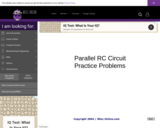
In this interactive object, students calculate capacitive reactance, impedance, current, and power in parallel RC circuits.
- Subject:
- Electrical engineering
- Engineering
- Date Added:
- 10/15/2010

In this interactive object, students calculate capacitive reactance, impedance, current, and power in parallel RC circuits.
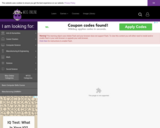
Learners alter circuit variables and view how these changes affect circuit voltage, current, reactance, impedance, and phase angle.
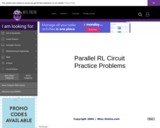
In this interactive object, students calculate inductive reactance, impedance, current, and power in parallel RL circuits.

Learners alter circuit variables and view how these changes affect circuit voltage, current, reactance, impedance, and phase angle.

Students work practice problems in which the total resistance of the circuit is calculated. Feedback is provided.
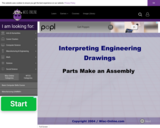
Learners examine the relationship of individual parts in an assembly drawing. Assembly drawing notes, fabricated and purchased parts, and sectional views are explained briefly.

Learners view a demonstration showing that line-neutral voltages and line-line voltages are not in-phase with each other, but have a definite 30-degree relationship.
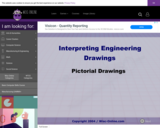
Learners examine pictorial drawings used in engineering including sectioned and exploded drawings. A sketching quiz is provided to help the learner create simple pictorial sketches by using orthographic views and an isometric template.

Learners read about the benefits of storing raw materials within 3 feet of the work area where they will be used.

Learners view examples of devices that prevent mistakes from occurring.

In this animated and interactive object, learners examine how a variable voltage is obtained from a variable resistor that is wired as a potentiometer across a fixed DC power supply.
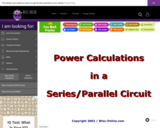
Students read about the various ways to calculate the power consumed in a series/parallel circuit. A brief quiz concludes the activity.

Learners read about the concepts of true power, reactive power, and apparent power, and are introduced to the power factor formula. A short quiz completes the activity.

Learners read an analogy comparing mechanical work (in this case, sliding a weight) to that of electrical power. The relationship of work, apparent work, and power factor is developed.

Students read an explanation of power factor correction. Examples of both inductive and capacitive loads are given.

Students read an explanation of power factor in a power distribution and how it can be improved by using a power factor correction capacitor bank. A brief quiz completes the activity.

Learners review the three formulas for power and work 12 problems. In each of the problems, students are given two of the three variables (voltage, resistance, or current) and asked to solve for power. Immediate feedback is provided.

Learners review the three formulas for power and work 12 problems. In each of the problems, students are given two of the three variables (voltage, resistance, or current) and asked to solve for power. Immediate feedback is provided.

Learners review the three formulas for power and work 12 problems. In each of the problems, students are given two of the three variables (voltage, resistance, or current) and asked to solve for power. Immediate feedback is provided.

Learners review the three formulas for power and work 12 problems. In each of the problems, students are given two of the three variables (voltage, resistance, or current) and asked to solve for power. Immediate feedback is provided.